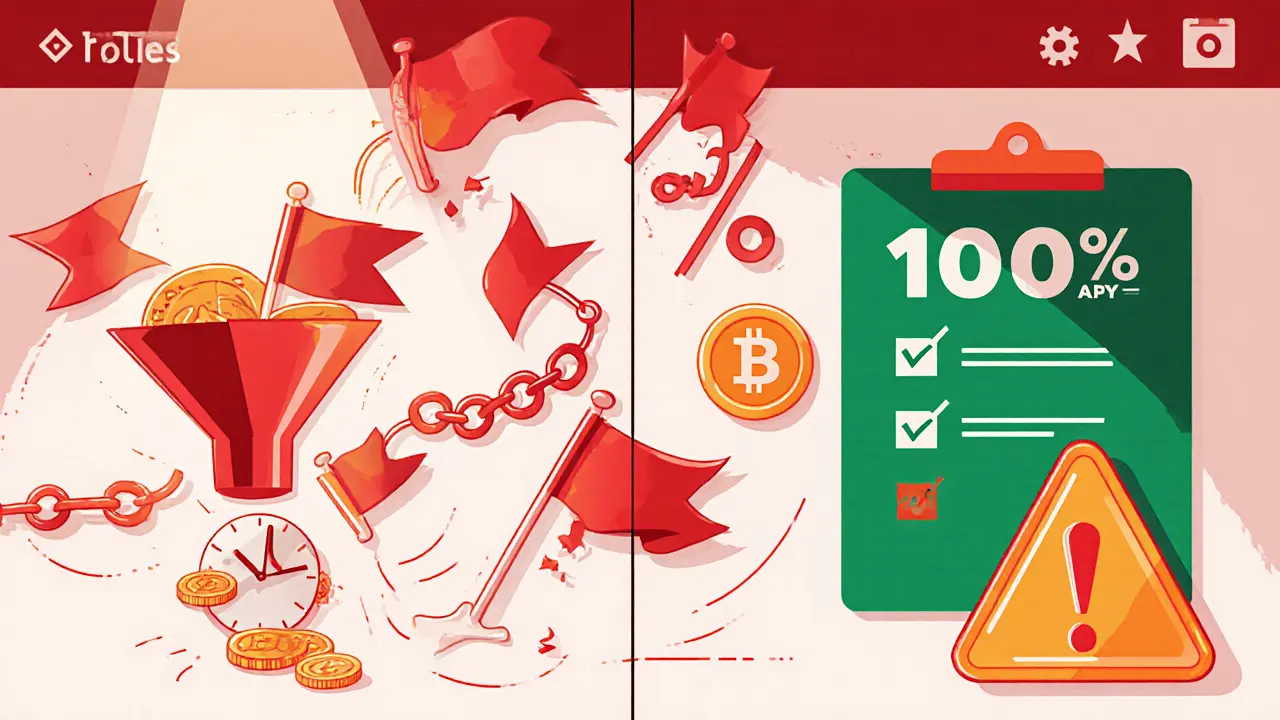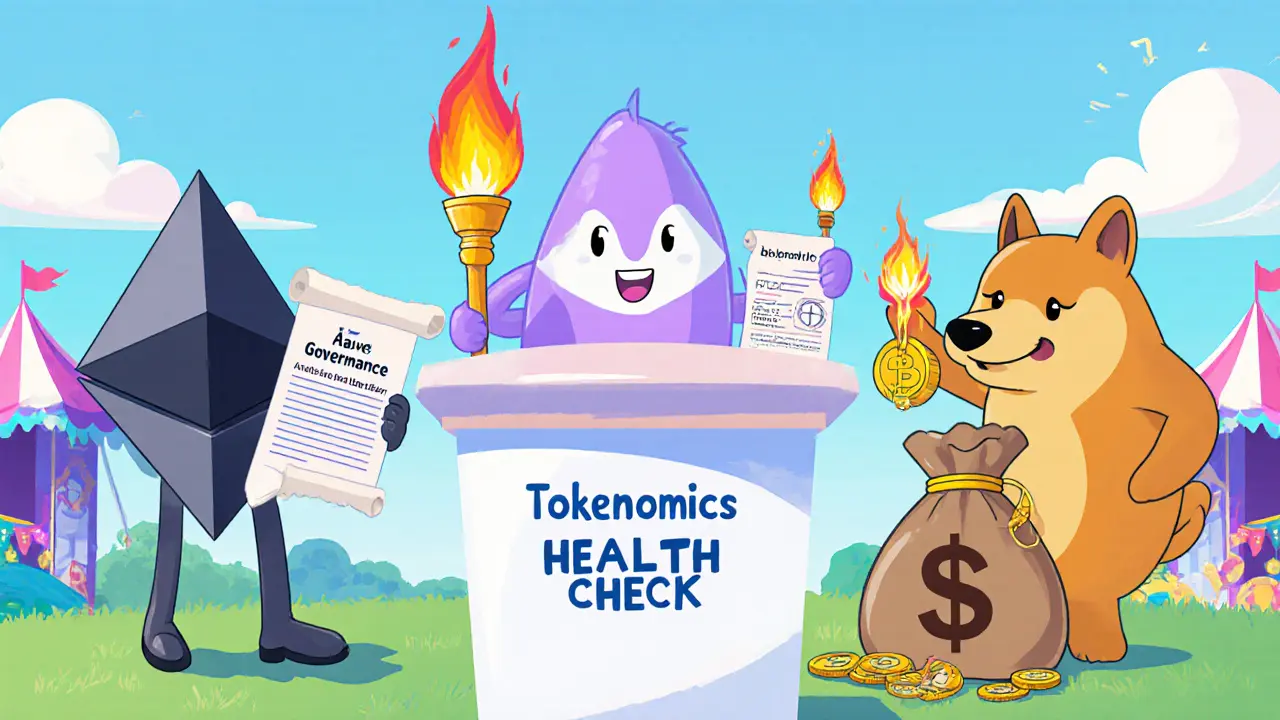Tokenomics Red Flag Checker
Project Analysis Tool
Enter details about a cryptocurrency project below to evaluate its tokenomics for potential red flags.
When you hear about a new coin promising sky‑high returns, the first thing you should check isn’t the price chart - it’s the economics behind the token. Tokenomics the set of rules that dictate how a cryptocurrency’s supply, distribution, and utility work determines whether a project can survive years of market cycles or burns out in weeks.
TL;DR - Quick Red‑Flag Checklist
- Unlimited or poorly controlled total supply
- No transparent burn or emission schedule
- Insider vesting that unlocks large amounts fast
- Token with no real‑world utility
- Over‑engineered models hiding centralization
- APY promises >100% without a revenue source
Why Tokenomics Matters More Than Hype
Investors often chase hype because it’s easy to spot - bold memes, celebrity endorsements, and flashy Twitter threads. The hard truth is that hype can’t offset a broken economic model. Projects with sound tokenomics tend to retain user interest, attract institutional capital, and survive regulatory scrutiny. Conversely, a flawed supply mechanic can turn even a technically brilliant protocol into a losing proposition.
Common Red Flags to Watch
1. Unlimited Token Supply Without Deflationary Controls
An endless supply creates constant inflation, eroding the value of every token you hold. Ethereum originally had an uncapped supply, but the network introduced EIP‑1559 to burn a portion of transaction fees, creating a modest deflationary pressure. Dogecoin, on the other hand, still follows a pure infinite‑supply model, resulting in predictable yearly inflation that many investors view as a value killer.
2. Missing or Vague Burn Mechanisms
Tokens that never leave circulation can’t develop scarcity. Look for clear documentation of regular token burns or fee‑forwarding mechanisms. If a project mentions “future burns” without a schedule or on‑chain proof, treat it as a warning sign.
3. Aggressive Vesting Schedules for Team and Investors
When founders or early investors can sell large chunks of tokens shortly after launch, the market often sees a sudden price dump. A healthy vesting schedule locks a substantial portion for at least 12‑24 months with a linear release. Anything faster, especially with >30% of total supply allocated to insiders, is a red flag.
4. Tokens Lacking Genuine Utility
If the token is only used for speculation-buy, hold, sell-there’s no reason for it to retain value once the hype fades. Look for utility such as governance rights, fee discounts, access to services, or staking rewards tied to actual network activity.
5. Over‑Engineered Economic Layers
Complex designs featuring ten‑plus layers of staking, bonding, minting, and burning can mask centralization or hidden supply leaks. Simplicity often equals transparency; intricate mechanisms should be justified with clear, on‑chain data.
6. Unsustainable APY Promises
Annual Percentage Yields that exceed 100% without a clear revenue model are almost always a liquidity trap. Once fresh capital dries up, the protocol can’t sustain those payouts, leading to a rapid collapse.

How to Evaluate Tokenomics - A Step‑by‑Step Framework
- Check Total Supply the maximum number of tokens that can ever exist on CoinGecko or CoinMarketCap. Is there a hard cap?
- Read the whitepaper for an Emission Schedule the plan for how new tokens are minted over time. Are minting rates decreasing?
- Identify any Burn Mechanism the process that permanently removes tokens from circulation. Look for on‑chain burn events.
- Analyze the Vesting Schedule the timeline over which team and early investor tokens become liquid. Prefer linear releases with cliffs.
- Assess the Utility the real functions the token performs within its ecosystem. Does it power a service, enable governance, or pay fees?
- Scrutinize Staking the act of locking tokens to secure the network or earn rewards models. Are rewards funded by protocol revenue?
- Examine any promised APY the projected annual return on staked tokens. Verify the source of rewards.
- Look for Governance the framework allowing token holders to influence protocol decisions. Strong governance aligns incentives.
Real‑World Examples: Good vs. Bad Tokenomics
Tokenomics isn’t just theory - it’s visible in how projects perform over time. Below are three well‑known protocols that illustrate the spectrum.
- Ethereum: Started without a burn, later added EIP‑1559 to introduce fee burning, gradually reducing net supply growth. Its token has clear utility as gas for transactions and strong governance via EIP proposals.
- Aave: Uses a governance‑centric model where the AAVE token grants voting rights and fee discounts. Emission schedules are transparent, and a portion of fees is burned each quarter, creating a modest deflationary effect.
- Dogecoin: Infinite supply with a fixed annual emission of 5billion coins, no burn, and minimal utility beyond tipping. The token relies entirely on community hype, leading to persistent inflationary pressure.
Comparison Table: Tokenomics Health Check
| Metric | Ethereum | Aave | Dogecoin |
|---|---|---|---|
| Total Supply | ~120M (as of 2025) | ~16M | Unlimited (5B/year) |
| Max Supply | None (capped by EIP‑1559 burns) | None (controlled emissions) | None |
| Burn Mechanism | Base‑fee burn via EIP‑1559 | Quarterly fee‑burn | None |
| Vesting Transparency | Team 12‑month cliff, 4‑year linear | Team 12‑month cliff, 4‑year linear | Founders hold 30% with no lock‑up |
| Utility | Gas fees, staking, governance | Governance, fee discounts, liquidity mining | Tip & meme culture |
Practical Tips & Next Steps
- Start with the checklist above before committing any funds.
- Use on‑chain explorers (Etherscan, BscScan) to verify burn events and vesting contracts.
- Cross‑reference data on multiple aggregators - discrepancies are usually a red flag.
- Join community channels (Telegram, Discord, Reddit) and ask for token‑distribution proof.
- Keep a spreadsheet of each project's metrics; patterns emerge across dozens of tokens.
By consistently applying these steps, you’ll filter out projects that look shiny but crumble under economic pressure, and you’ll position yourself to back protocols with genuine, sustainable value.

Frequently Asked Questions
What is a token supply cap and why does it matter?
A supply cap sets the maximum number of tokens that can ever exist. When a cap is fixed, scarcity can increase as demand grows, helping to preserve or boost value. Unlimited supplies often lead to inflation, diluting each holder’s share.
How can I verify a project's burn mechanism?
Check the blockchain explorer for burn transactions linked to the token contract. Reputable projects publish burn logs on their website and often include a transparent dashboard showing cumulative tokens burned.
Why are high APY promises risky?
Very high APY usually relies on fresh capital inflow or speculative token price increases. When new deposits slow down, the protocol cannot meet the promised payouts, causing a sudden crash.
What role does governance play in healthy tokenomics?
Governance lets token holders vote on protocol upgrades, fee structures, and emission changes. When governance power aligns with token holders’ interests, it encourages long‑term stewardship instead of short‑term dumping.
Can I rely solely on a project’s whitepaper for tokenomics analysis?
Whitepapers are a starting point, but they can be vague or outdated. Always cross‑check claims with on‑chain data and third‑party audits before making investment decisions.


Dyeshanae Navarro
Tokenomics is the backbone of any crypto – if the supply rules are messed up, the whole project crumbles fast.